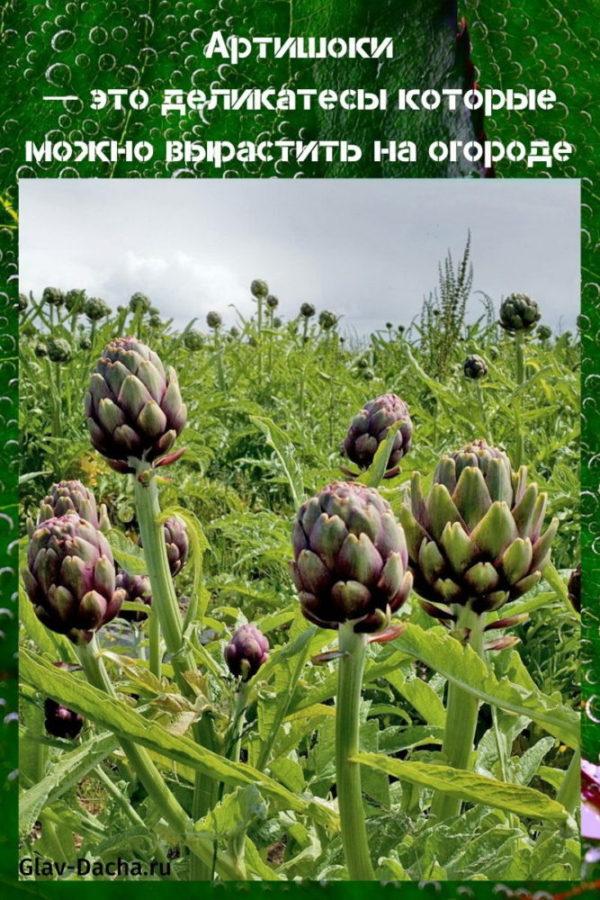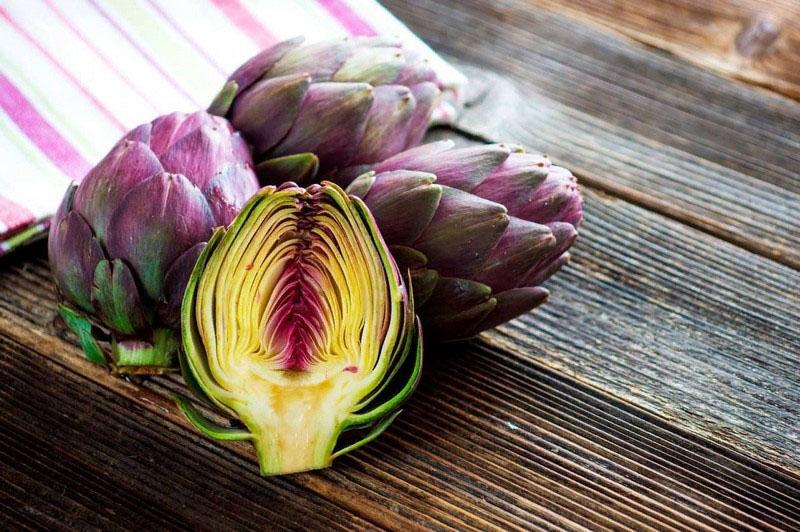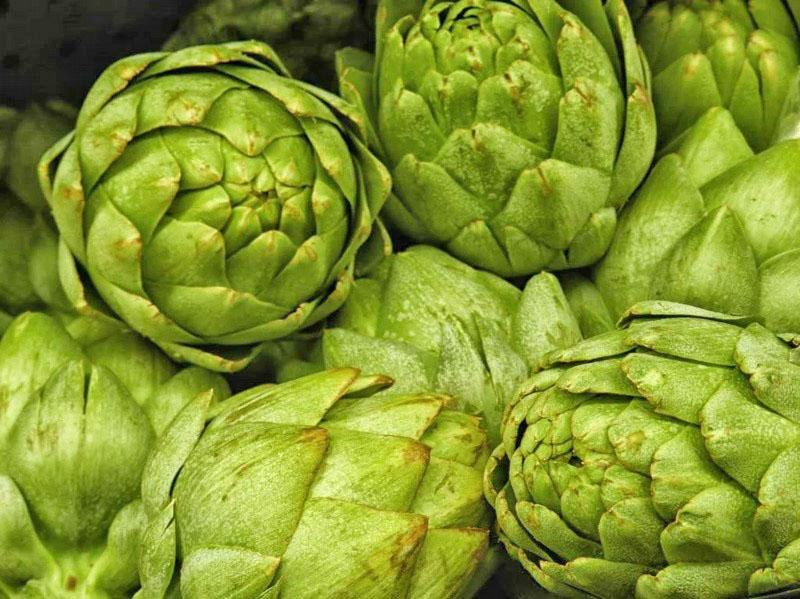Artichokes are delicacies that can be grown in the garden
 Artichokes are perennial plants that belong to the Aster family. Together with asparagus and rhubarb, they belong to the dessert types of vegetables. Their unopened, edible buds taste like nuts and are therefore highly valued by gourmets. Some of them have many thorns on the outer leaves. How to properly peel and cook artichokes, as well as grow yourself, can be found in this article.
Artichokes are perennial plants that belong to the Aster family. Together with asparagus and rhubarb, they belong to the dessert types of vegetables. Their unopened, edible buds taste like nuts and are therefore highly valued by gourmets. Some of them have many thorns on the outer leaves. How to properly peel and cook artichokes, as well as grow yourself, can be found in this article.


Outwardly, the artichoke plant is not much different from the curly thistle, and they both belong to the same family. You can identify them by the color and size of the buds.
Valuable properties of artichoke
 Not all people know what artichokes are. Their chemical composition is incredibly rich.
Not all people know what artichokes are. Their chemical composition is incredibly rich.
There are many in the receptacle:
- fiber;
- nitrogenous substances;
- sugars;
- bitterness;
- carotene;
- tannins;
- manganese;
- phosphorus;
- vitamins C and group B.
There are mineral salts of potassium and iron, flanoids are present. Of greatest value is the presence of easily assimilated inulin (reserve polysaccharide), which is necessary in diabetes mellitus and prevents the development of atherosclerosis.
Artichokes are very popular in France and Italy. In these countries, they can be purchased in supermarkets from October to June, as some varieties bear fruit several times a year.
Purchased artichokes should be fresh, unopened, with no dried out tips. Old inflorescences are practically inedible. If a part of the stem is cut off together with the bud, it is thrown away, just like the upper, most rigid scales.
Artichoke is a non-nutritive product; it is used in dietary nutrition by people for whom excess weight becomes dangerous. Thanks to inulin, beneficial bacteria are produced in the human intestine, and the blood sugar level is reduced. The value of the cenarin contained in artichoke is to improve cerebral circulation.
Preparations made from artichoke are used in the treatment of obesity and anorexia. The beneficial substances contained in it improve the absorption and absorption of fats in the human body. Healing tinctures, juices, decoctions are prepared from the leaves and roots of the artichoke.
In addition, the artichoke is a good diuretic and choleretic agent. But even such a useful plant may have contraindications.
Not everyone can use it for food or for medicinal purposes; people who belong to the following groups should refuse a tasty delicacy:
- children under 12 years old;
- pregnant and lactating women;
- existing blockage of the biliary tract;
- the presence of individual intolerance to individual plant components, the manifestation of allergic reactions;
- severe form of liver failure.
People with gastritis, complicated by low acidity, suffering from hypertension, should not consume artichokes without first consulting their doctor.
Cooking use
 In a real or prickly artichoke, only buds are eaten. While its close relative, the Spanish artichoke, can delight its admirers with edible parts of roots and stems of shoots. Only now its cones are almost half the size.
In a real or prickly artichoke, only buds are eaten. While its close relative, the Spanish artichoke, can delight its admirers with edible parts of roots and stems of shoots. Only now its cones are almost half the size.
Artichoke buds can be eaten raw. They are also boiled, fried, stewed and canned. Add to salads, sautés, sauces. Soups cooked with them acquire an extraordinary aroma and exquisite taste.
Artichoke buds are fairly spiny and not entirely edible. You need to buy them only fresh, otherwise they darken over time, their pleasant smell disappears.
The young apical buds of the artichoke are suitable for making all kinds of snacks, while the medium-sized buds can be stewed and fried. The pith cut into thin slices is added to salads. Artichokes prepared in this way are a great addition to rice dishes.
How to peel artichokes
 You can buy artichoke hearts (hearts) canned or frozen at the store. But fresh buds have a higher taste. True, they need to be able to select and clean. In addition, processed artichokes are not stored. When raw, they should be eaten immediately. And if they were added to the dishes and at the same time underwent heat treatment, then on the day of preparation.
You can buy artichoke hearts (hearts) canned or frozen at the store. But fresh buds have a higher taste. True, they need to be able to select and clean. In addition, processed artichokes are not stored. When raw, they should be eaten immediately. And if they were added to the dishes and at the same time underwent heat treatment, then on the day of preparation.
Store unpeeled artichokes in the refrigerator for no more than two weeks. The peeled kernels are prepared immediately. During storage, they darken and turn sour. You cannot freeze them either. To prevent the artichokes from darkening, they are dipped in water with the addition of a small amount of citric acid or table vinegar.
Clean the artichokes with gloves. They are necessary in order not to be pricked with thorns and in the process of work, dark spots do not appear on the fingers. You will also need a knife and a convenient container of water, lemon.
Phased work:
- water is poured into the container and lemon slices are added to it;

- the stem is cut off from the artichoke;

- remove the top of the bud, about one third, and immediately immerse it in lemon water, otherwise it will darken;

- all hard leaves are cut off, leaving young and delicate, light ocher color;

- the bud is cut into two halves and the fluff inside is taken out, along with a small amount of foliage, and the artichoke is placed back in the water.

The leg should not be thrown away. It can still come in handy. It is fairly easy to remove a tough surface with a vegetable peeler. And the light core can be used in the same way as the bud: it is baked in the oven, deep-fried, added to salads and soups.
Artichokes are the best addition to any dish
The flavor and beneficial properties of artichokes gradually weaken during long-term storage. After the first week, they begin to absorb moisture and all kinds of odors from the environment. Therefore, they are immediately processed and canned, or various dishes are prepared with them.
One of the most famous recipes for making delicious buds in Italian cuisine is “Roman Artichokes”.
The following ingredients are required:
- 4 fresh, firm to the touch artichokes with green outer petals;
- a small bunch of parsley, just a littlelemon balm;
- quality extra virgin olive oil;
- lemon juice;
- 1 clove of garlic;
- about 2 tablespoons of ground crackers;
- salt and pepper to taste.
Cooking method:
- Artichokes are cleaned, the fibers are extracted from the core. They also clean the leg of the artichoke, leave a length of about 5 cm, you do not need to cut it off.

- Artichokes are put in a bowl of water with lemon juice diluted in it.

- Prepare the mixture. Chop garlic, parsley leaves and lemon balm. Stir with salt, pepper, ground breadcrumbs. Add olive oil.

- Move the remaining artichoke leaves apart. Turn down and drain all the water. Not only the free central part is filled with the resulting mass, but also the gaps between the petals.

- Stuff all the buds, set them tightly in a deep frying pan, legs up. Its sides should be slightly higher than the artichokes.Pour in a mixture of water and olive oil in a 1: 1 ratio.

- Put on medium heat and cook for 10 minutes. Then reduce the heat and, depending on the size of the buds, bring it to readiness for another 15-20 minutes.
The cooked fruit is served along with the sauce in which it was stewed. They are delicious hot, but many connoisseurs prefer to eat them cold.
How to grow an artichoke
 The artichoke is a thermophilic plant. Its flowers are damaged at a temperature of -1 ° C, and if it drops by another degree, a disaster is coming - they finally die off. Therefore, in the Non-Black Earth Region, as in many regions of Russia, the artichoke should be grown by seedlings. The only exception can be the southern regions with stable warm weather in early spring.
The artichoke is a thermophilic plant. Its flowers are damaged at a temperature of -1 ° C, and if it drops by another degree, a disaster is coming - they finally die off. Therefore, in the Non-Black Earth Region, as in many regions of Russia, the artichoke should be grown by seedlings. The only exception can be the southern regions with stable warm weather in early spring.
There are many foreign varieties. But in our country, Laonsky and Violet early are popular. Of the varieties of domestic selection, Maikop-41, Krasavets, Gurman are known. Breeding an artichoke is not that difficult. You can use different methods: by seeds, dividing rhizomes or root layers. On average, an artichoke bush grows in the garden for about 5 years.
The artichoke planting site or beds should be located on southern slopes, if the landscape allows for this, and protected from cold winds.
The soil must be prepared in advance. Light, with neutral acidity will do. In late autumn, the allocated area is dug up. At the same time add rotted manure, compost, ash, fertilizers containing potassium, as well as double superphosphate.
The best predecessors are potatoes, legumes, and root vegetables. You cannot plant an artichoke in an area where Jerusalem artichoke or various types of salads were previously grown.
Seed preparation for sowing
 This is the usual way that is used everywhere:
This is the usual way that is used everywhere:
- The seeds are taken out of the bag, and placed in a glass or small jar, filled with water. Leave for 10 hours, and then wrap it in a wet cloth and film to keep the moisture longer. In a warm place, they will hatch after about 5 days.

- A piece of paper or vermiculite is folded into a small plastic bag with a fastener for better germination. Iron the bag with your palm, remove excess air and close it. Then place in the refrigerator. Chilling the seeds for 15 days will increase the yield of the artichoke in the first year after planting.
- Seeds are planted in boxes filled with turf soil, sand and humus, taken in equal proportions. For this, grooves are made, the depth of which should reach 1.5 cm. Seeds are laid out every 3 cm. This must be done carefully so as not to break off the sprouts.

- The seeds are sprinkled with earth, watered with a spray bottle and the boxes are placed on the windowsill. Do not cover them with glass. It is only important to ensure that the soil does not dry out.
After the appearance of the first true leaf, the seedlings must be dived, pinched off the tip of the root, for the formation of a further developed root system. The grown plants gradually begin to harden and, with the onset of warm weather, are planted in the beds.
Seedling method
 Growing plants in this way allows you to get fleshy buds in the first year. From the beginning of February, artichoke seeds are germinated in specially prepared sawdust at room temperature. Those of them that have sprouted are subjected to vernalization. Place in a refrigerator on the lower shelf for two weeks or take out into a room with a constant temperature of about + 2 ° C. Small upward fluctuations are allowed.
Growing plants in this way allows you to get fleshy buds in the first year. From the beginning of February, artichoke seeds are germinated in specially prepared sawdust at room temperature. Those of them that have sprouted are subjected to vernalization. Place in a refrigerator on the lower shelf for two weeks or take out into a room with a constant temperature of about + 2 ° C. Small upward fluctuations are allowed.
Then the seeds with darkened sprouts are planted in separate pots and placed in a warm and bright place. A greenhouse is considered the most suitable for this purpose. Caring for plants during this period is not difficult. It is necessary to water and loosen the soil in time, weed out the emerging weeds. The good condition of the plants contributes to the production of edible baskets within the first year.
Artichoke seedlings should be planted on the beds only after the threat of recurrent frosts has passed. Plants do not suffer from small cold snaps.
Experienced gardeners recommend stopping watering a few days before planting artichoke plants in open ground. The turgor of the leaves will decrease, they will look sluggish. But you cannot bring them to a dry state! The creation of such an artificial drought causes an increased stemming of the bush, which in turn has a positive effect on the yield of the heads.
The method of obtaining buds in the second year of cultivation is the division of rhizomes
 It is not always possible to wait for the artichoke harvest in cold climates in the first year after planting in the ground. But you can try to grow fragrant baskets in the second year. Moreover, they turn out to be larger.
It is not always possible to wait for the artichoke harvest in cold climates in the first year after planting in the ground. But you can try to grow fragrant baskets in the second year. Moreover, they turn out to be larger.
In late autumn, artichokes are dug out of the ground, all leaves are removed, and a few of the youngest are left. Do it in dry weather. Store on shelves in the basement all winter. In the spring, each root is cut into two or three parts so that each of them has a living kidney.
On a garden bed three meters long and at least one wide, 10 artichoke seedlings are planted in two rows. Install metal arcs and cover the entire structure with a film. In addition to watering and loosening, plants need ventilation. As soon as the artichokes grow to the film and rest against it with their tops, they are provided with an exit - a hole is cut out in the film. After that, the artichokes continue to grow upward, without a lack of fresh air and sunlight. However, their roots left in the greenhouse are kept warm and provide the plants with sufficient nutrients.
Artichoke care
 After that, the plant has undergone adaptation and began to develop foliage, it is necessary to feed it. Slurry is perfect for this business. After a couple of weeks, mineral fertilization will be needed, subsequently fertilization is needed every 14 days until the end of the growing season. It is also necessary to loosen the soil for the first few weeks. If the plant is infected with a parasite such as aphids, then leaf treatment is needed wood ash... If you add potassium chloride to it, you get an excellent remedy that will drive away aphids for a long time.
After that, the plant has undergone adaptation and began to develop foliage, it is necessary to feed it. Slurry is perfect for this business. After a couple of weeks, mineral fertilization will be needed, subsequently fertilization is needed every 14 days until the end of the growing season. It is also necessary to loosen the soil for the first few weeks. If the plant is infected with a parasite such as aphids, then leaf treatment is needed wood ash... If you add potassium chloride to it, you get an excellent remedy that will drive away aphids for a long time.
Water the artichoke generously, but not too often. This will prevent the soil from getting too wet. Flowering begins in August-September. After it, watering should be reduced. If you plan to harvest seeds, you need to leave 2-3 inflorescences on the bush, but do not let them ripen completely. Before freezing, you will need to trim the central stem. The bed can be covered with peat or soil by 20 cm.
Harvesting
 The main sign of maturity is mobile scales. The assembly of inflorescences is possible within a couple of weeks after they have formed. Since they do not ripen at the same time, a phased collection is required. It is worth considering that overripe fruits are unsuitable for food, while unripe fruits do not yet have saturation.
The main sign of maturity is mobile scales. The assembly of inflorescences is possible within a couple of weeks after they have formed. Since they do not ripen at the same time, a phased collection is required. It is worth considering that overripe fruits are unsuitable for food, while unripe fruits do not yet have saturation.
The cones must be cut along with part of the stem, 3-4 cm will be enough. Freshly picked has the richest taste, but the artichoke can be kept in the refrigerator for up to a month. It can also be salted, pickled, or frozen to keep it stored for a longer period of time.